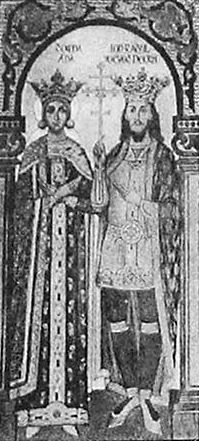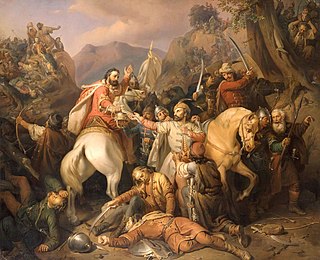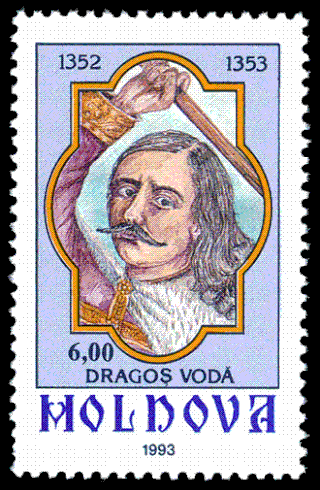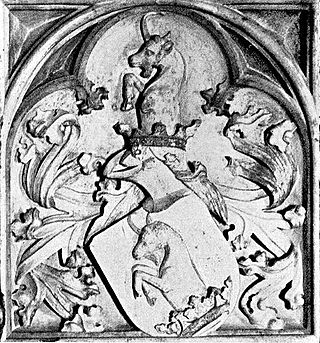
Wallachia or Walachia is a historical and geographical region of modern-day Romania. It is situated north of the Lower Danube and south of the Southern Carpathians. Wallachia was traditionally divided into two sections, Muntenia and Oltenia. Dobruja could sometimes be considered a third section due to its proximity and brief rule over it. Wallachia as a whole is sometimes referred to as Muntenia through identification with the larger of the two traditional sections.
The Middle Ages in Romania began shortly after the withdrawal of the Roman legions from the former Roman province of Dacia in the late 3rd century and with the start of the Early Middle Ages and the Migration Period that followed afterwards respectively. It subsequently came to an end with the reign of Domn Michael the Brave (1593–1601) who managed, for a short time between 1599 and 1600, to rule Wallachia, Moldavia, and Transylvania together, the three principalities whose territories were to be united some three centuries later to form modern and contemporary Romania.

Curtea de Argeș is a municipality in Romania on the left bank of the river Argeș, where it flows through a valley of the Southern Carpathians, on the railway from Pitești to the Turnu Roșu Pass. It is part of Argeș County. The city also administers one village, Noapteș.
Seneslau, also Seneslav or Stănislau, was a Vlach voivode mentioned in the Diploma of the Joannites issued by king Béla IV of Hungary (1235–1270) on 2 July 1247. The diploma granted territories to the Knights Hospitaller in the Banate of Severin and Cumania. According to the diploma, the king gave the territories east of the Olt River to the knights, with the exception of the territory of voivode Seneslau.
Thocomerius, also Tihomir, was the father of Basarab, who would become the first independent voivode of Wallachia. Many Romanian historians, such as Vlad Georgescu and Marcel Popa, believe that Thocomerius was a voivode in Wallachia who succeeded Bărbat, who ruled around 1278; others, such as Tudor Sălăgean, refer to him as a local potentate whose status cannot be specified.

Radu I was a Voivode of Wallachia. His year of birth is unattested in primary sources. He was the son of Nicolae Alexandru and half-brother and successor to Vladislav I. He is identified by many historians as the legendary Radu Negru, a mythical voievode of the early medieval state Wallachia, founder of the state's institutions and ruler.

Negru Vodă, also known as Radu Negru, was, according to the legend, the founder and the first Voievode of Wallachia.

The Battle of Posada was fought between Basarab I of Wallachia and Charles I of Hungary.

Dragoș, also known as Dragoș Vodă, or Dragoș the Founder was the first Voivode of Moldavia, who reigned in the middle of the 14th century, according to the earliest Moldavian chronicles. The same sources say that Dragoș came from Maramureş while chasing an aurochs or zimbru across the Carpathian Mountains. His descălecat, or "dismounting", on the banks of the Moldova River has traditionally been regarded as the symbol of the foundation of the Principality of Moldavia in Romanian historiography. Most details of his life are uncertain. Historians have identified him either with Dragoș of Bedeu or with Dragoș of Giulești, who were Vlach landowners in the Kingdom of Hungary.

Bogdan I, commonly known as Bogdan the Founder, was the first independent ruler, or voivode, of Moldavia in the 1360s. He had initially been the voivode, or head, of the Vlachs in the Voivodeship of Maramureș in the Kingdom of Hungary. However, when the first certain record was made of him in 1343, he was mentioned as a former voivode who had become disloyal to Louis I of Hungary. He invaded the domains of a Vlach landowner who remained loyal to the king in 1349. Four years later, he was again mentioned as voivode in a charter, which was the last record of his presence in Maramureș.

The House of Basarab was a ruling family that established the Principality of Wallachia, giving the country its first line of Princes, one closely related with the Mușatin rulers of Moldavia. Its status as a dynasty is rendered problematic by the official elective system, which implied that male members of the same family, including illegitimate offspring, were chosen to rule by a council of boyars. After the rule of Alexandru I Aldea, the house was split by the conflict between the Dănești and the Drăculești, both of which claimed legitimacy. Several late rulers of the Craiovești claimed direct descent from the House after its eventual demise, including Neagoe Basarab, Matei Basarab, Constantin Șerban, Șerban Cantacuzino, and Constantin Brâncoveanu.
The Early Middle Ages in Romania started with the withdrawal of the Roman troops and administration from Dacia province in the 270s. In the next millennium a series of peoples, most of whom only controlled two or three of the nearly ten historical regions that now form Romania, arrived. During this period, society and culture underwent fundamental changes. Town life came to an end in Dacia with the Roman withdrawal, and in Scythia Minor – the other Roman province in the territory of present-day Romania – 400 years later. Fine vessels made on fast potter's wheels disappeared and hand-made pottery became dominant from the 450s. Burial rites changed more than once from cremation to inhumation and vice versa until inhumation became dominant by the end of the 10th century.
The founding of Wallachia, that is the establishment of the first independent Romanian principality, was achieved at the beginning of the 14th century, through the unification of smaller political units that had existed between the Carpathian Mountains, and the Rivers Danube, Siret and Milcov.
The founding of Moldavia began with the arrival of a Vlach (Romanian) voivode, Dragoș, soon followed by his people from Maramureș, then a voivodeship, to the region of the Moldova River. Dragoș established a polity there as a vassal to the Kingdom of Hungary in the 1350s. The independence of the Principality of Moldavia was gained when Bogdan I, another Vlach voivode from Maramureș who had fallen out with the Hungarian king, crossed the Carpathians in 1359 and took control of Moldavia, wresting the region from Hungary. It remained a principality until 1859, when it united with Wallachia, initiating the development of the modern Romanian state.

Justina Szilágyi de Horogszeg was a Hungarian noblewoman, who became the second wife of Vlad Dracula, Voivode of Wallachia. She was the daughter of Ladislaus or Osvát Szilágyi and thus a cousin of Matthias Corvinus, King of Hungary. Corvinus first gave her in marriage to Wenceslas Pongrác of Szentmiklós. Pongrác had inherited estates in Upper Hungary, but was forced to renounce them in exchange for landed property he and Justina jointly received in Transylvania following their marriage. After Pongrác died in 1474, the widowed Justina married Vlad, whom Corvinus acknowledged as the lawful voivode of Wallachia in 1475. Vlad seized Wallachia in late 1476, but soon died in battle. To strengthen her claim to her Transylvanian estates, she married Paul Suki, who was related to the former owners of those territories. After the death of Suki, in 1479, Justina was married to John Erdélyi of Somkerék, until her death in 1497.
Farcaș, also Farkas, Farkaș or Farcas, was a cneaz mentioned in the Diploma of the Joannites issued by king Béla IV of Hungary (1235–1270) on 2 July 1247; the diploma granted territories to the Knights Hospitaller in the Banate of Severin and Cumania. Farcaș held a kenazate which was given to the knights by the king. His kenazate lay in the northeast of modern Oltenia.

Andronikos Kantakouzenos, also known as Mihaloğlu Derviş, was an Ottoman Greek entrepreneur and political figure, primarily active in Wallachia and Moldavia. He was the son of Michael Kantakouzenos Şeytanoğlu, a powerful merchant of the Ottoman Empire, executed by Murad III in 1578. Forced to honor his father's outstanding debt, and briefly imprisoned as a galley slave, he rebuilt the fortune through commerce and political intrigues. In the 1590s, he was continuing his father's involvement as kingmaker for both Wallachia and Moldavia, acting as patron for a succession of Hospodars: Stephen the Deaf, Petru Cercel, Aaron the Tyrant and Peter the Lame all benefited from his financing. From 1591, he involved himself directly in the administration of both countries. Integrated within Moldo–Wallachian boyardom, he was Vistier, and then the first-ever Ban of Oltenia to be appointed directly by the Ottomans.

Țara Litua was a country from around Severin to the Olt River. The first mention of the country was in 1247, when Litovoi was its voivode. The country existed until 1330 when Basarab I founded Wallachia.

The military of Wallachia existed throughout the history of the country. Starting from its founding to 1860, when it was united with the Moldavian army into what would become the Romanian Army.
















